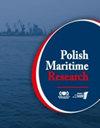Glass Microspheres Thermo-Deformation Sintering Processes in the Technologies of Obtaining Materials for Underwater Technical Equipment
IF 2
3区 工程技术
Q2 ENGINEERING, MARINE
引用次数: 0
Abstract
Abstract In this work, the important scientific and technical problem of creating multifunctional composite materials for shipbuilding and ocean engineering was solved. The work aimed to study the thermal deformation processes of sintering glass microspheres to obtain lightweight glass composites with a cellular structure that provides positive buoyancy and sound insulation properties. For this purpose, glass microspheres of Na 2 O‒SiO 2 and Na2O‒B 2 O 3 ‒SiO 2 composition with a dispersion of 10 to 60 μm were used as raw materials. They were sintered to form a closed, porous structure. The theoretical substantiation of technological parameters is based on the concepts of solid state and glassy state chemistry and physicochemical concepts of glass softening processes. The process of hot-pressing glass microspheres without plasticisers and additives was investigated. The author’s own laboratory equipment was used for the experiments. The sintering intensity was determined from the results of shrinkage processes; the kinetic shrinkage curves were constructed in semilogarithmic coordinates. The glass composite samples were examined by optical and electron microscopy. As a criterion, the storage of spherical microspheres under the influence of simultaneous heating to 700 °C with the application of pressure in the range of 0,5 to 1,5 MPa was chosen. It was established that the formation of a predominantly closed-porous structure of glass composites with a density of 350...600 kg/m 3 occurs by the mechanisms of viscous glass phase flow through liquefaction processes in the walls of microspheres. At the same time, shrinkage processes in the linear direction reach up to 50%. The acoustic properties were investigated by measuring the differences in sound pressure levels in octave frequency bands using a Kundt pipe. The water absorption of the glass composite samples was determined at hydrostatic pressures up to 20 MPa. The research results were compared with the characteristics of analogue composites, such as syntactic foams and foam glass. The developed materials can be used in the design and manufacture of technical equipment for research and maintenance of underwater infrastructure. The prospects for further research are related to the feasibility study and marketing research on implementing the developed glass composites.水下技术装备材料获取技术中的玻璃微球热变形烧结工艺
本文解决了船舶和海洋工程用多功能复合材料的重要科学技术问题。这项工作旨在研究烧结玻璃微球的热变形过程,以获得具有正浮力和隔音性能的细胞结构的轻质玻璃复合材料。为此,以分散度为10 ~ 60 μm的na2o - sio2和na2o - b2o - sio2组成的玻璃微球为原料。它们被烧结成封闭的多孔结构。工艺参数的理论依据是固态和玻璃态化学的概念以及玻璃软化过程的物理化学概念。研究了不添加增塑剂和助剂的玻璃微球热压工艺。实验使用了作者自己的实验室设备。根据收缩过程的结果确定烧结强度;在半对数坐标系下构造了运动收缩曲线。用光学显微镜和电子显微镜对玻璃复合材料样品进行了检测。作为标准,选择了同时加热至700℃,施加0.5 ~ 1.5 MPa压力的球形微球的存储。结果表明:玻璃复合材料以闭孔结构为主,密度为350…600 kg/ m3是通过微球壁液化过程中的粘性玻璃相流动机制产生的。同时,在线性方向上的收缩率可达50%。利用昆特管测量声压级在八度频带内的差异,研究了其声学特性。在静水压力为20 MPa时,测定了玻璃复合材料样品的吸水率。将研究结果与合成泡沫和泡沫玻璃等类似复合材料的特性进行了比较。开发的材料可用于水下基础设施研究和维修技术设备的设计和制造。进一步研究的前景与实施所开发的玻璃复合材料的可行性研究和市场研究有关。
本文章由计算机程序翻译,如有差异,请以英文原文为准。
求助全文
约1分钟内获得全文
求助全文
来源期刊

Polish Maritime Research
工程技术-工程:海洋
CiteScore
3.70
自引率
45.00%
发文量
20
审稿时长
>12 weeks
期刊介绍:
The scope of the journal covers selected issues related to all phases of product lifecycle and corresponding technologies for offshore floating and fixed structures and their components.
All researchers are invited to submit their original papers for peer review and publications related to methods of the design; production and manufacturing; maintenance and operational processes of such technical items as:
all types of vessels and their equipment,
fixed and floating offshore units and their components,
autonomous underwater vehicle (AUV) and remotely operated vehicle (ROV).
We welcome submissions from these fields in the following technical topics:
ship hydrodynamics: buoyancy and stability; ship resistance and propulsion, etc.,
structural integrity of ship and offshore unit structures: materials; welding; fatigue and fracture, etc.,
marine equipment: ship and offshore unit power plants: overboarding equipment; etc.
 求助内容:
求助内容: 应助结果提醒方式:
应助结果提醒方式:


